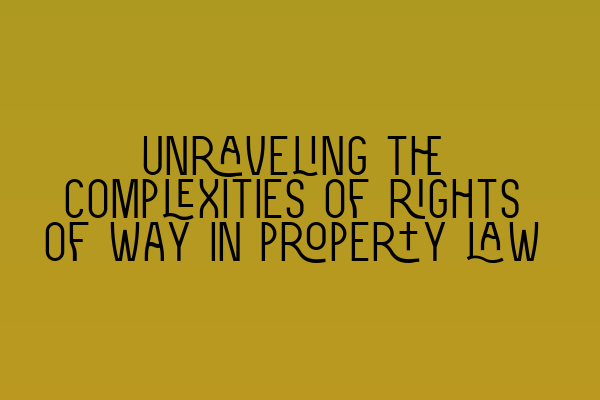Unraveling the complexities of rights of way in property law
As a property owner or potential buyer, it is essential to have a good understanding of your legal rights and obligations when it comes to accessing and using your property. One significant aspect of property law that often poses complexities is the concept of rights of way. In this blog post, we will unravel the intricacies of rights of way and provide you with valuable insights to navigate this area of property law.
A right of way is a legal easement that grants someone the right to pass through or use a portion of another person’s property. It allows for access to a particular area of land, such as a driveway, pathway, or road, either on foot or by vehicle. This right may be held by the owner of an adjacent property, a utility company, or even the general public in some cases.
Understanding the different types of rights of way
1. Public rights of way: These are rights of way that are available for use by the general public. They are usually established to provide access to public land or amenities such as parks, beaches, or hiking trails. Public rights of way are often governed by local authorities and can be found on official maps and documents.
2. Private rights of way: These are rights of way that are limited to specific individuals or entities. They may be created through a legal agreement, such as a deed or contract, or by long-standing usage over time. Private rights of way can be accessed by the owner of the dominant tenement (the property benefiting from the right) and sometimes by others with the owner’s permission.
3. Prescriptive rights of way: These are rights of way that are acquired through long-term, uninterrupted use without the need for a legal agreement. For example, if someone has been using a particular route to access their property for a significant period, they may acquire a prescriptive right of way. To establish a prescriptive right of way, certain requirements must be met, such as the use being open, continuous, and without permission from the landowner.
Resolving disputes related to rights of way
Rights of way can often lead to disputes between property owners, especially when there is a disagreement over the scope or existence of the right. Common issues that can arise include obstruction of the right of way, excessive use, or disagreements regarding maintenance responsibilities.
If you find yourself in a rights of way dispute, it is advisable to seek legal advice from a property law expert. They can help you understand your rights and obligations, explore potential solutions, and represent your interests during negotiations or court proceedings if necessary.
It is also worth noting that rights of way can impact property values and development plans. Potential buyers or investors should thoroughly investigate any existing rights of way on a property before making a purchase or planning construction projects, as they may have implications on access, usage, and future developments.
Conclusion
Navigating the complexities of rights of way in property law can be challenging, but understanding the different types and legal requirements is crucial for property owners and potential buyers. Whether you are dealing with public rights of way, private rights of way, or prescriptive rights of way, seeking professional legal advice is always advisable to ensure your rights are protected.
At SQE Property Law & Land Law, our team of experienced solicitors specializes in property matters, including rights of way. We can provide expert guidance, negotiate on your behalf, or represent you in court if necessary. Contact us today to schedule a consultation and find out how we can assist you.
Related Articles:
– SQE 1 Practice Exam Questions
– SQE 1 Practice Mocks FLK1 FLK2
– SQE 2 Preparation Courses
– SQE 1 Preparation Courses
– SRA SQE Exam Dates
